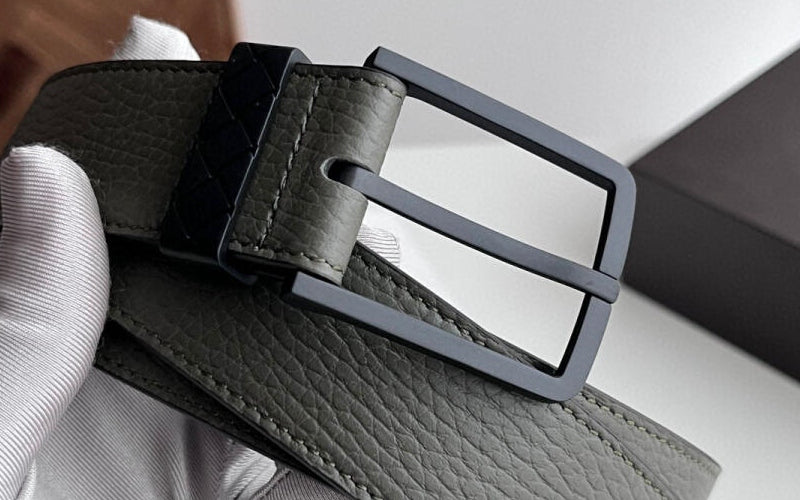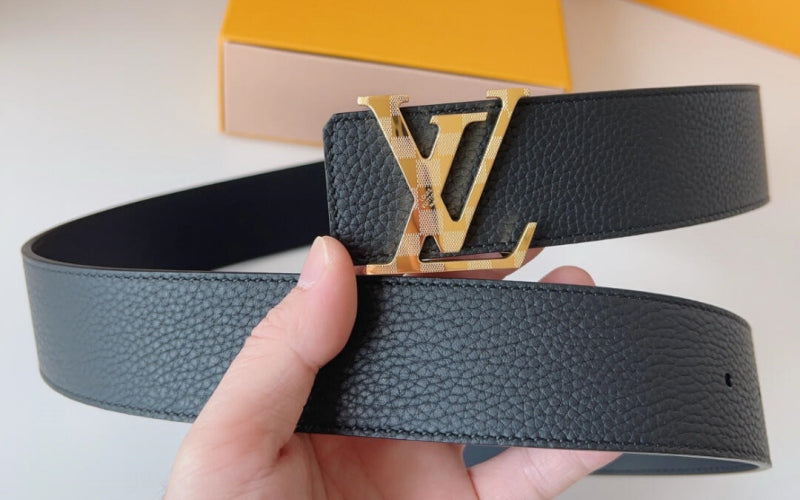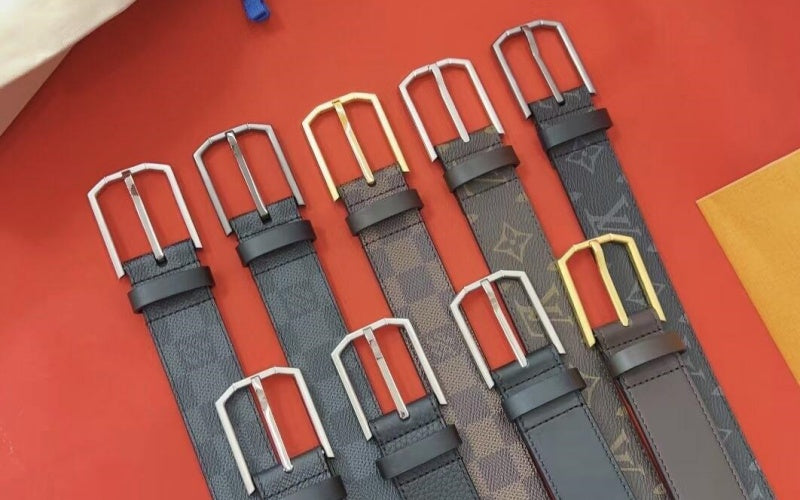
Is a Genuine Leather Belt Real Leather?(Expert Answer by BELTLEY)
Let’s cut through the marketing fluff: The term “genuine leather” is the Willy Wonka of the fashion world—it sounds magical, but the reality is far less sweet.
Spoiler alert: Yes, genuine leather is technically real leather… but calling it “quality” is like calling a gas station sushi roll “fine dining.”
At Beltley, where transparency is our motto, we’re ripping back the curtain on this misleading label, exposing why most “genuine leather” belts are doomed to crack, and teaching you how to spot the real deal.
 Want more belt styles? Click the image above to see more!
Want more belt styles? Click the image above to see more!
The Leather Hierarchy: What “Genuine” Really Means
Leather isn’t just “real” or “fake.” It’s graded based on which part of the hide is used and how it’s processed. Here’s the breakdown, ranked from “trash can-bound” to “heirloom-worthy”:
1. Bonded Leather – The Frankenstein of Materials
-
What It Is: Pulverized scraps glued together and painted to look uniform.
-
Pros: Costs less than a Starbucks latte.
-
Cons: Disintegrates faster than a TikTok trend.
-
Beltley’s Take: “We’d rather sell belts made of spaghetti.”
2. Genuine Leather – The Wolf in Sheep’s Clothing
-
What It Is: The split layer (bottom half) of the hide, sanded smooth and coated with plastic or paint.
-
Pros: Affordable and widely available.
-
Cons:
-
Thin: Often less than 1mm thick.
-
No Patina: The plastic coating prevents natural aging.
-
Lifespan: 6–12 months with daily use.
-
Beltley’s Warning: “If it’s labeled ‘genuine leather’ and under $50, you’re buying a time bomb.”
3. Top-Grain Leather – The Crowd-Pleaser
-
What It Is: The top layer of the hide, sanded to remove imperfections and given a glossy finish.
-
Pros: Scratch-resistant, smooth, and mid-range pricing.
-
Cons: Lacks the character and breathability of untouched leather.
-
Beltley’s Pick: Our Polished Executive Belt – ideal for office warriors on a budget.
4. Full-Grain Leather – The Gold Standard
-
What It Is: The entire top layer of the hide, untouched by sanding or correction. Natural scars and grain remain visible.
-
Pros:
-
Durability: Thick (2–3mm) and resistant to wear.
-
Breathability: Molds to your body over time.
-
Aging: Develops a rich patina that tells your story.
-
Cons: Pricier upfront (but cheaper per wear over decades).
-
Beltley’s Hero: The Legacy Full-Grain Belt – handcrafted in Italy, guaranteed for life.
 Want more belt styles? Click the image above to see more!
Want more belt styles? Click the image above to see more!
Why “Genuine Leather” Is a Red Flag
The term “genuine leather” isn’t a lie—it’s a loophole. Here’s why it’s become the industry’s dirtiest secret:
-
Legal Trickery: In many countries, any product containing leather scraps can be labeled “genuine.”
-
Greenwashing: Brands slap “genuine leather” on marketing materials to trick eco-conscious shoppers.
-
The Fast-Fashion Trap: Companies like H&M and Zara use “genuine leather” to justify higher prices for low-quality goods.
Pro Tip: If a product only says “genuine leather” without specifying the type (full-grain, top-grain), assume it’s the lowest grade.
 Want more belt styles? Click the image above to see more!
Want more belt styles? Click the image above to see more!
How to Spot Fake “Genuine Leather” – A Forensic Guide
Don’t get duped. Use these tricks to separate the treasures from the trash:
1. The Smell Test
-
Real Leather: Smells earthy and rich, like a saddle shop.
-
Fake/Genuine Leather: Smells like plastic or chemicals.
2. The Edge Inspection
-
Full-Grain: Rough, fibrous edges (like a steak’s crust).
-
Genuine Leather: Smooth, painted edges that look like cardboard.
3. The Bend Test
-
Full-Grain: Develops subtle creases (like a human palm).
-
Genuine Leather: Cracks or shows white lines when bent.
4. The Water Test
-
Full-Grain: Absorbs water slightly, then dries unharmed.
-
Genuine Leather: Water beads up (thanks to plastic coating) or causes warping.
Beltley Hack: Carry a mini UV flashlight. Real leather fluoresces differently than synthetic materials.
 Want more belt styles? Click the image above to see more!
Want more belt styles? Click the image above to see more!
The Beltley Difference: Why We Never Use “Genuine Leather”
At Beltley, we’d rather eat glass than sell you a subpar belt. Here’s our philosophy:
-
Full-Grain or Bust: 98% of our belts use full-grain leather. The 2%? Exotics like shell cordovan.
-
Vegetable Tanning: Our leather is tanned using oak bark and chestnut extract, not toxic chromium.
-
Zero Correction: We leave natural scars and grain intact—because perfection is boring.
-
Transparency: Every belt comes with a “Leather Birth Certificate” detailing its origin and tanning process.
 Want more belt styles? Click the image above to see more!
Want more belt styles? Click the image above to see more!
Leather Care: How to Make a Full-Grain Belt Outlive You
A Beltley belt isn’t a purchase—it’s a legacy. Treat it right:
-
Clean Monthly: Wipe with a damp cloth. For stubborn stains, use saddle soap.
-
Condition Quarterly: Massage in Beltley’s Leather Elixir (a blend of beeswax and jojoba oil).
-
Rotate Often: Don’t wear the same belt daily. Let it rest to retain shape.
-
Store Smartly: Hang or roll—never fold. Keep away from heat and sunlight.
Pro Tip: Spilled wine? Blot immediately with baking soda. For Beltley belts, we offer free stain removal for life.
 Want more belt styles? Click the image above to see more!
Want more belt styles? Click the image above to see more!
FAQs: Your Leather Lies, Debunked
Q: Why do brands use “genuine leather” if it’s low quality?
A: Because it’s technically true and lets them charge more for cheap goods. Always ask, “What type of genuine leather?”
Q: Can genuine leather belts be repaired?
A: Not really. The thin layer can’t be stitched or conditioned effectively. Full-grain is fixable for decades.
Q: Is vegan leather better than genuine leather?
A: Vegan leather (usually PVC) is worse—it cracks faster and pollutes oceans. For eco-friendly options, try our Cork Leather Collection.
Q: How long does a full-grain belt last?
A: With proper care, 20–30 years. We’ve had customers pass theirs down as family heirlooms.
Q: Does “Made in Italy” guarantee quality?
A: Not always. Some brands ship cheap leather to Italy for final stitching. Beltley sources and crafts in Italy.
 Want more belt styles? Click the image above to see more!
Want more belt styles? Click the image above to see more!
The Dark Side of Leather: What Most Brands Won’t Tell You
-
Fast Fashion’s Secret: 70% of “genuine leather” belts contain harmful azo dyes linked to cancer (Source: EcoWatch).
-
Environmental Impact: Chrome tanning (used for genuine leather) pollutes waterways with hexavalent chromium.
-
Worker Exploitation: Many tanneries pay workers $2/day without protective gear.
Beltley’s Promise: We partner with SA8000-certified tanneries, pay living wages, and use 100% renewable energy.
 Want more belt styles? Click the image above to see more!
Want more belt styles? Click the image above to see more!
Real Talk: Why You Should Never Settle for “Genuine”
A belt isn’t just an accessory—it’s a daily companion that witnesses your life’s highs and lows (and questionable karaoke choices). Settling for “genuine leather” is like marrying someone who’s technically alive—sure, they exist, but where’s the passion? The longevity? The story?
At Beltley, we craft belts that age with you, not against you. Each scratch, crease, and coffee stain becomes a badge of honor—proof of a life well-lived.
Ready to Upgrade Your Legacy? Shop Beltley’s Full-Grain Collection and use code BELTLEY15 for 15% off. Because you deserve more than a “genuine” lie.
P.S. Still clinging to that peeling genuine leather belt? Mail it to us. We’ll give it a proper funeral (and you 15% off). 😉

